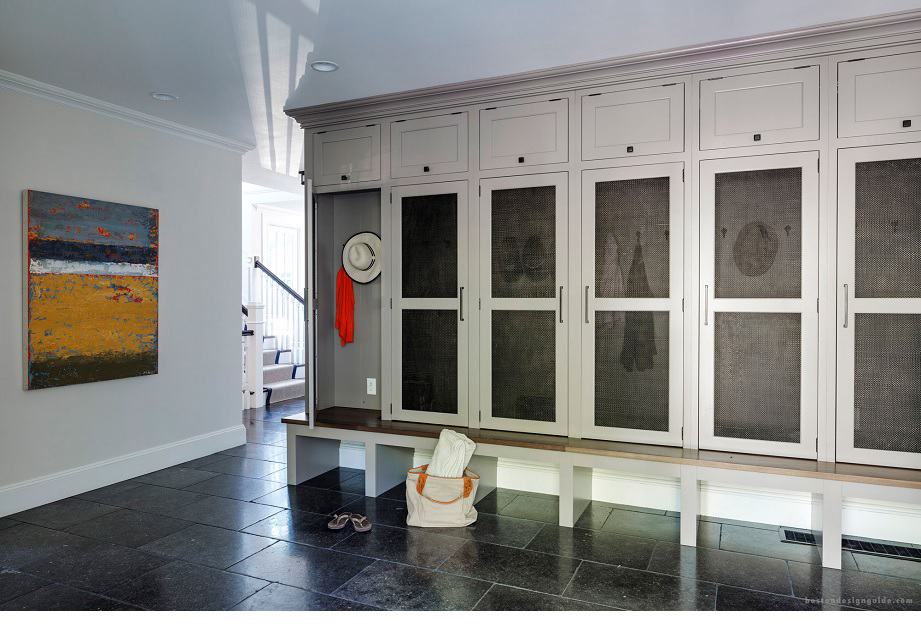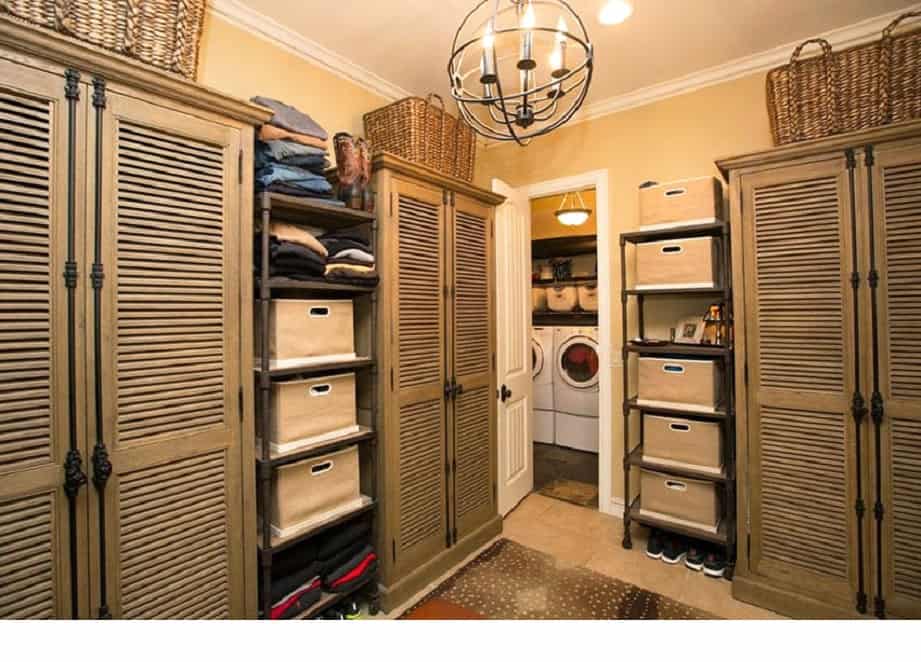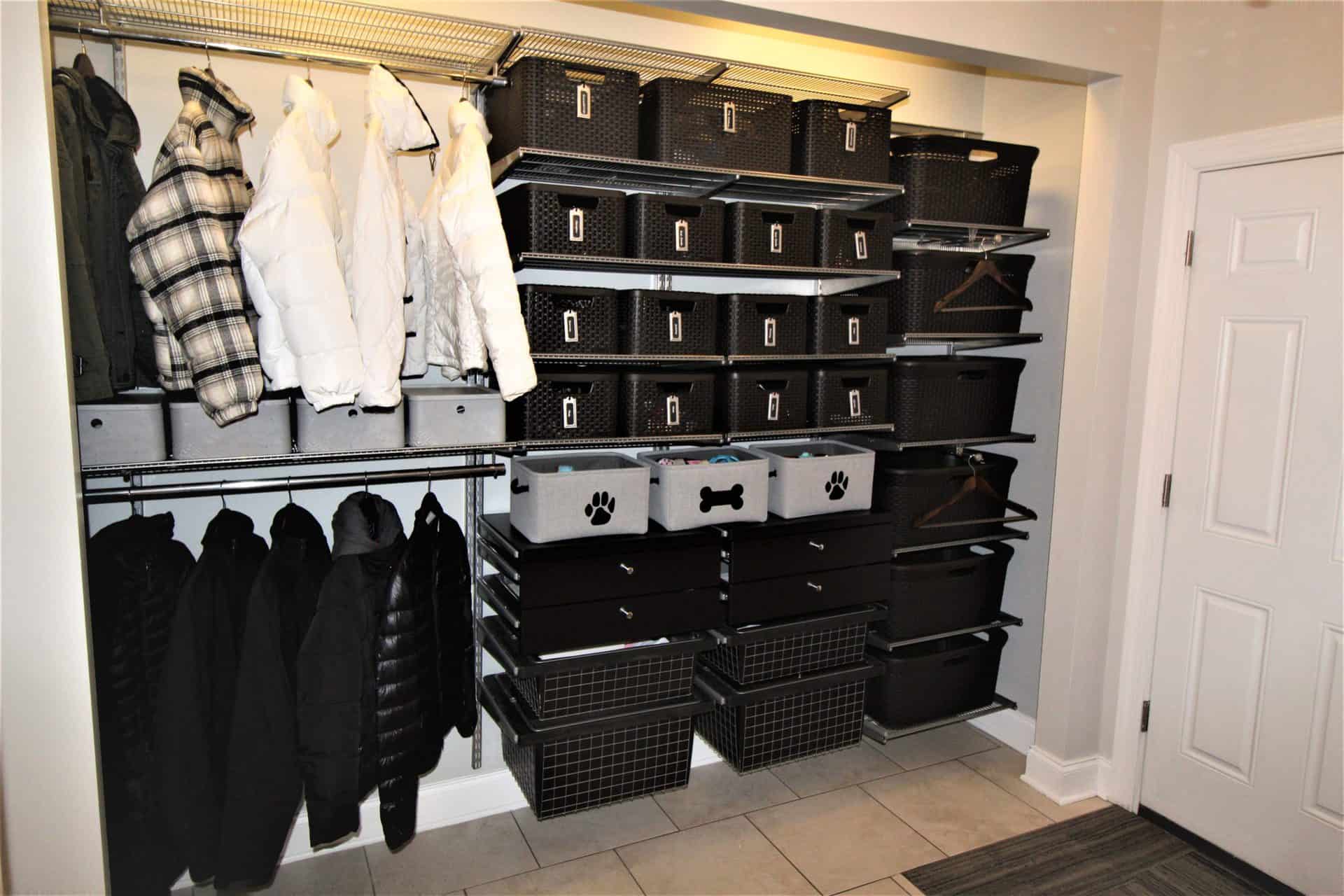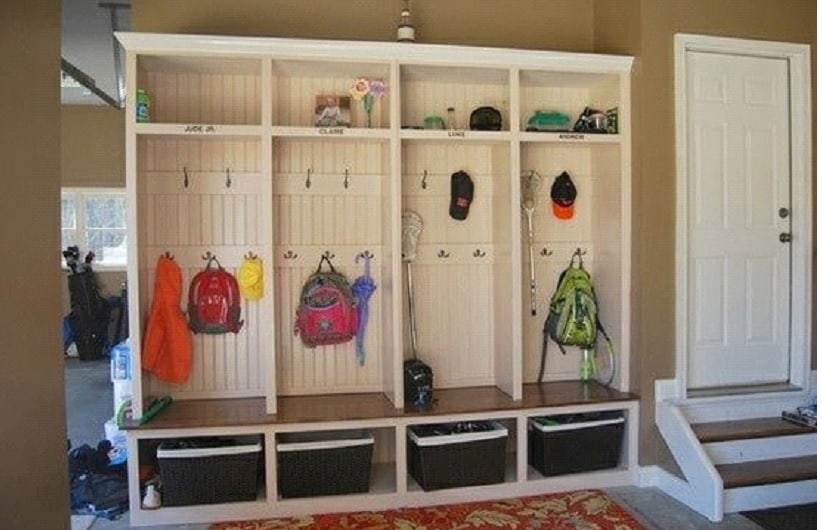Before you can even begin to arrange the space in a mudroom, you must completely declutter your belonging. Keep what you use, love, and need. Also, decide what must get contained in the room. A mudroom is a room that can serve multiple purposes; therefore, prioritize which items are most important, because, in the end, you may not be able to get everything to fit in this space. Also, consider storing off-season items out of the mudroom so that you can make the best use of this space. For example, seasonal coats, shoes, sporting goods, and so on should rotate and store elsewhere, like in a storage room.
Once you downsize all the mudroom belongings, you are ready to arrange the room. You know which items will remain in the place, so it’s easier to determine the amount of space needed. You’ll also select the appropriate storage organizers sized in proportion to what they’re intended to hold. Depending upon the amount of work necessary to complete your mudroom organizational project, using a notebook to record measurements and draw room sketches can help plan your space accurately. Useful measurements to take are room dimensions, accounting for doors, windows, or any obstructions. The same goes for any closets. Then sketch a diagram of the room, figuring that any fixed organizers are staying, such as a closet system or shelving. Before shopping for anything, settle on a budget. When you need to purchase new organizers or a closet system, do some research first because many choose from—search online or in specialty stores and organization stores. Please make a list of the organizers that appeal to you and their dimensions. Check prices so you can make the best choice given a budget.
Thoroughly clean and paint the entire mudroom, if desired. Whether you plan your mudroom in your head or on paper, purchase any needed organizers or closet systems and put the room together. The following images show how a mudroom can be arranged, given different budgets, which will dictate the types of organizational essentials or closet systems chosen. Recognize the option to mix high-end, middle ground, and budget-friendly organizers in the same mudroom.

Upscale Mudroom
There are many things to include in an upgraded mudroom. First and foremost, good quality cabinetry marks a high-end mudroom. Since a mudroom typically takes a beating, it’s important that your cabinets are solid and come with heavy-duty hardware that can handle abuse. Investing in mudroom cabinetry is a good choice when the room is viewed from entertainment areas like a kitchen or family room.
Cabinetry is the ultimate organizer since it can be outfitted with many accessories that contain items perfectly. It also hides everything. A pantry cabinet may be a good option if space allows. Standard heights for pantry cabinets are eighty-four inches, ninety inches, and ninety-six inches. Standard pantry cabinet widths vary more than height, ranging between nine inches and thirty-six inches, typically in three-inch increments (nine inches, twelve inches, fifteen inches, eighteen inches, etc.). A pantry cabinet can resemble a closet and be equipped with multiple pullout shelves for footwear, sports equipment, totes, sports bags, backpacks, briefcases, pet supplies, picnic baskets, audio/video equipment, and so on. Basic stationary shelving placed in a pantry needs to be adjustable to respond to changing storage needs. Cleaning supplies and tools are also perfect items for cabinet pantry storage. Mount stationary pegs or retractable hook organizers onto the inside walls of the pantry for holding items like brooms, mops, dustpans, dusters, and the like. Add overhead shelving and use the floor to place cleaners, hand tools, buckets, and organizers to transport cleaners to other rooms of the home. Upper cabinets in a storage room can store everyday articles, such as trash liners, flashlights, light bulbs, insect repellant, first aid kits, air deodorizers, lighters, shipping supplies, gift-wrapping supplies, batteries, and so on. When arranging articles in the cabinets, keep items of similar nature grouped together in a designated area on the shelf to help you remember where things are located. For example, a toolbox, hardware oil lubricants, glue, tape measure, light bulbs, and picture-hanging supplies can be stored next to each other. Many articles can file or stand in rows on the shelves, like cans and bottles of insect repellent. Groups of small articles are best stored in open stacking bins. However, such belongings are good to contain in handled containers for portability when these items are taken out of the mudroom. Although a more expensive feature, upper cabinets can include common dead space by extending them to the ceiling for added cabinet storage space. Higher placed cabinet shelving can store infrequently used or off-season articles, such as coolers, picnic baskets, beach towels, sand toys, and so on. Many different organizers can be installed in the base cabinets, such as pullout shelves, trash cans, hampers, and recycling containers. One of the most useful aspects of cabinetry is drawer storage. Little odds and ends, such as rubber bands, safety pins, and lighters are great to stash in compartmentalized drawer trays or divider containers. A custom built-in locker system is another high-end feature to add to a mudroom. The main advantage of using lockers in a home is they perfectly separate household members’ personal items, such as a coat, backpack, purse, shoes, and so on. Inside the locker door, a personal chalkboard or corkboard can be placed, which is useful for individual reminders or for posting personal documents. A custom locker setup can have an attached built-in bench with pullout drawers beneath the seat for additional storage. If space allows, a floor sink is a big upgrade to any mudroom. Not only useful to bathe the family pet, but also it’s big enough to clean large items like sporting goods, pots, boots, mops, buckets, and bulky garage items.

Semi-custom Mudroom
A semi-custom mudroom can easily mimic an upscale one simply by using well-designed, moderately priced organizers. Many cabinet distributors and home centers carry stock cabinetry that costs significantly less than custom or special order. With the right design, a mudroom outfitted with such cabinets adds significant storage capacity and increases the home’s value. A good selection of cabinet organizers is sold separately outside a cabinet line and is easy to find at specialty storage and organization stores, as well as many home centers. There are rollout shelves, pullout baskets, trash cans, or hampers that will fit most standard cabinets. Also, many loose organizers, such as baskets, trays, and containers, can compartmentalize items. Freestanding lockers are another type of organizer that can fall into the moderately priced budget. However, there are many types of freestanding lockers designed to outfit a mudroom, and some can be costlier. Classic ventilated steel lockers, which are found in schools, break rooms, gyms, or fitness centers, can be found at stores that sell industrial products and also at many home centers. Many furniture stores carry mudroom furniture in the form of semi-custom, entryway lockers, which are commonly featured in a solid wood construction designed for the home. These entry systems typically have a top cubby compartment and an open locker with coat hooks and are finished with a bench seat. The sides of the lockers are flush, so you can line up as many lockers as needed, which creates a cohesive, custom look. A sink is an expensive upgrade for a mudroom due to plumbing costs, but the benefits are endless. When you already have a sink or plan to install one, prepare a highly functional space. There are two types of sinks: a utility or traditional countersink. A utility sink will require wall-mounted organizers and perhaps a floor organizer to contain sink items in lieu of cabinets. A countersink will have a base-cabinet storage compartment and matching upper cabinets—always the best way to obtain wall storage.
In a mudroom, a sink is called to perform cleaning duties. Therefore, a wall-mounted, counter or cabinet paper-towel dispenser is needed. Cleaning soaps should be easy to access from a wall-mounted or counter dispenser.

Budget-friendly Mudroom
An economical way to furnish a mudroom is to install an inexpensive DIY, wire-based closet system right onto the mudroom wall. Most home centers carry off-the-shelf closet systems that come in kits with basic shelving and hanging rods. These kits are helpful for those who struggle with organizing because the manufacturers do the basic thinking for the consumer by including ready-made layouts from which to choose. Most closet kits offer additional organizers that can be purchased separately, such as pullout baskets, hampers, hooks, and the like, so it’s to your advantage to select a system that has many such organizer accessory add-ons. A closet system becomes an open-storage arrangement when mounted onto a mudroom wall, so it should be arranged neatly since it’s so visible. If needed, add extra storage essentials to help maintain order. For example, add baskets to divide and contain many groups of different belongings. There are many ways to configure a wire closet system in the mudroom, given different accessories. A hanging rod can be added to hang outwear or sports uniforms. Attach S hooks to the hanging rod for all looped belongings, such as backpacks, totes, handbags, and certain sporting goods. Shoe organizers or shelving can hold footwear. For an open space, opt for wire shelving since solid varieties are prone to dust in such settings. Slanted or pullout shoe organizers are easiest to view and access. Pullout baskets can contain many items, such as outwear accessories, sporting goods, pet items, drawstrings, backpacks, water bottles, trash liners, and so on. Pullout hampers, recycling bins, and trash cans are other common closet-system organizers that work nicely in a mudroom.

Mudroom Equipped For Children
The mudroom is a great place to teach children responsibility by having them put all their things away upon entering the home. Also, a mudroom can stop their belongings from becoming scattered throughout the home. In order to successfully contain children’s belongings in the mudroom, organizers must be scaled to their size so they’re easy to use. Lockers, cubbies, and benches are primary children’s organizers they’re comfortable with since they’re used at school. It’s a good idea to use either picture or worded labels on organizers for children. It’s also helpful to have a bulletin board for children’s papers, notes, calendars, and so on for their use, which fosters responsibility

A Garage With Mudroom Duties
Some homes don’t have a separate mudroom space; therefore, an attached garage can take on mudroom duties when organizers can be arranged around the doorway to the home. A great advantage to using the garage for this purpose is being able to clean or leave messy, wet belongings in the garage, as opposed to ever having them enter the home. Another benefit’s being able to use less expensive or heavy-duty commercial grade storage organizers that would otherwise not look as appropriate inside the home. Almost any traditional mudroom organizer, such as benches, cubby organizers, or lockers, work in a garage space. There are commercial-grade, heavy-gauge steel garage organizers that are formed into racks or lockers that are durable and practical for mudroom items, such as footwear, back backs, sporting goods, and so on. Many home centers and specialty garage organizational storage companies sell cabinetry designed to store tools, automotive and gardening supplies, and outdoor items. These cabinet lines are also good for storing mudroom belongings. Other garage organizers, such as the commonly marketed wall systems that come with attachable organizers, can also be used for mudroom items. The problems with using the garage for mudroom belongings are the fluctuating temperatures of seasonal climates and common garage debris or dust. A good way to combat some of the problems is to choose organizers that are enclosed, such as cabinets and lockers.
